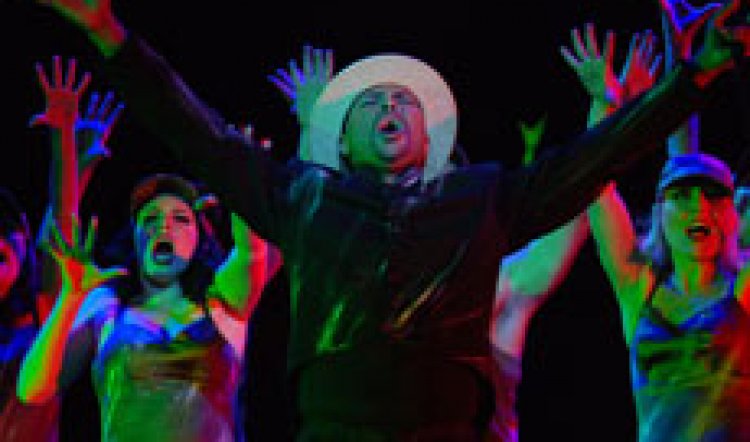
Pippin
Pippin: His Musical Journey,with music and lyrics by Stephen Schwartz and book by Roger Hirson, was a pretty big hit on Broadway (early 70s) and a not-so-big hit in London soon afterwards. Various productions around the world followed including one in Melbourne featuring a young John Farnham in the title role. There have been a telly version and uncounted amateur productions since then. And now, some 30 years on, it's Peter Cousens' choice as the first show from his new Kookaburra outfit - the self-styled "national musical theatre company". (One would have to wonder what Jeanne Pratt thinks of that description.)
Meanwhile, this new initiative has already achieved amazing backing from the federal government, the corporate sector and theatre industry in Sydney. As well, it has drawn on huge funds of goodwill as there seems to be a genuine desire to see a company get up and produce work to showcase the deep well of Australian song-and-dance talent now available and looking for jobs.
So why choose Pippin? It is question that, despite overwhelming goodwill for the idea and Cousens' persistence, was being widely asked after the opening night performance, albeit via whispers and graphically-raised eyebrows. If an Australian company is going to trawl for material in the Broadway musical pond, citing - as was asserted in recent weeks - the dearth of musicals with strong stories and music - it seems perverse to pick one from the shallow end.
True, Jeanne Pratt's terrific Production Company has, in the past decade, mounted many of the acknowledged greats (think Camelot, Oklahoma!, The Pajama Game, Sunset Boulevard, Kiss Me Kate, High Society, Annie Get Your Gun, South Pacific, High Society, Carousel, Bye Bye Birdie) but these short-season, high production values shows were seen only in Melbourne after the company's one costly excursion north with Hair!.
Just listing these fabled heavyweights serves as a reminder that no amount of goodwill, talent and energy could lift Pippin out of the second division. And, at the same time, that picking a show with both artistic merit and box office appeal is like playing Russian roulette with your bank account. Just ask John Diedrich, whose finances carked along with his 2006 production of Titanic.
If an elderly (aka classic) and as yet un-Jeanne-ed musical is thought to be the way to go, Kookaburra could do worse than consider Oh What a Lovely War, Grab Me a Gondola, Irma La Douce, or Lola Montez.
Or a totally radical idea would be to make a concerted effort to nurture new Australian talent: after Keating and with a new show on the front burner, Casey Bennetto is on the brink of fulfilling early promise of first rate musical theatre talent. Given the right creative partners, Phil Scott and Max Lambert could also be capable of a major musical. And the current star of Pippin - Matthew Robinson - has already written a show: Metro Street which, irony of ironies, won the 2004 Pratt Prize for Music Theatre. What's happening to that? (It has a cast of four - hardly a budget-breaker.)
[page]Meanwhile, dollops of the cream of musical theatre talent have busted their buns to drag Pippin from well deserved obscurity. That they ultimately fail is not their fault.
Starting from the very beginning - the title. How could anybody (even someone who had already written Godspell) have thought a hero named Pippin was a good idea? Why not call him Ditzy or Prince Stupidhead and have done with it? In the goofy 70s it might just have been possible to get away with it ... but actually, no, it wasn't. The downhill slide continues with a story that may have its origins in history but is nevertheless, silly as a wheel.
Historically Pippin was actually Pepin the Hunchback, younger son of Charlemagne, the emperor who united France. Despite Phantom, however, differently-abled persons are not popular in musical theatre, so this Pippin is a spunky, hunky young thing. He comes home from uni dissatisfied with the prospect of court life and instead heads off to seek experience and meaning. There are curious elements of The Truman Show in the mix of "real" and make believe - and Matt Robinson displays some of Jim Carrey's manic innocence as Pippin is steered on his adventures by The Leading Player who may be the Devil, and who surrounds him with fourth-wall breaking performers and knowing asides to the audience.

 Pippin investigates sex, war and religion and all are found wanting. Ennui and disillusion reign. He shimmies half-heartedly through a psychedelic-style orgy or two, a peasant revolt and even patricide with nary a backward glance. Conscience, morality and even plausibility are notably absent, which might have been interesting concepts in other hands (Sondheim, for instance). In the second half he meets Catherine, a widow and foot fetishist with a young son and a duck. He succumbs to the idea of falling in love with all the conviction of a Bollywood star bopping into an arranged marriage.
Pippin investigates sex, war and religion and all are found wanting. Ennui and disillusion reign. He shimmies half-heartedly through a psychedelic-style orgy or two, a peasant revolt and even patricide with nary a backward glance. Conscience, morality and even plausibility are notably absent, which might have been interesting concepts in other hands (Sondheim, for instance). In the second half he meets Catherine, a widow and foot fetishist with a young son and a duck. He succumbs to the idea of falling in love with all the conviction of a Bollywood star bopping into an arranged marriage.
Of the players, Matthew Robinson is exceedingly cute and can sing, but doesn't do innocent very well. Catherine is played with considerable and typical charm by Sharon Millerchip and she lights up the second half. The first half highlight is in the scene-stealing hands of glam and savvy Trisha Noble as Pippin's grandmother. As The Leading Player, Bert Labonte is great to look at, can sing and dance up a storm but entirely lacks devilishness - he desperately needs to project a touch of Scarpia.
[page]The absence of the devilish centre permeates the rest of the show, making it even more anaemic and irrelevant than it may actually be. As director-choreographer, Ross Coleman's choreography is vivacious, witty, precise and imaginative and pays homage to Bob Fosse's original. As director, he doesn't seem to have such a sure grip on characterisation and how to achieve it, proving how difficult it is to amalgamate the two jobs.
Gabriela Tylesova's design is a mix of modernist backdrops and disco outfits and is eye-catching and effective, for the most part. Trudy Dalgliesh's lighting design is the show's best artistic achievement and adds immeasurably to the staging. Michael Tyack is one of our finest musical directors but, for whatever reason, this is not his finest hour. With six musicians alongside him, including two other keyboard players, the band is thin, dull and unconvincing. (Consider what was accomplished by fewer players for Penrith's recent Sunday in the Park with George to figure that there is something seriously awry with Pippin's pit.) On opening night the sound quality was patchy: forehead mikes on the performers either not cutting in or amplifying the unintended, as well as a tinny quality to some voices which just shouldn't happen.
If Kookaburra is to succeed in its stated aim of becoming a thriving musical theatre company, the drawing board needs to be revisited in a hurry. In particular, wider artistic counsel should be urgently sought in the matter of repertoire. And the future vision needs clarification too: playing a wonky version of Advance Australia Fair at the beginning of the evening is a symptom of Kookaburra's times being out of joint. Just when Australia seems to be finally baulking at John Howard's white picket fence vision of Australia, Peter Cousens would have us return to Brigadoon.
Now there's a thought - what about Brigadoon?
Pippin: His Musical Journey, Sydney Theatre to May 19; ph: 1300 888 412 or www.sydneytheatre.org.au.
You can hear an interview with Matthew Robinson in Episode 15 of Stagecast.



